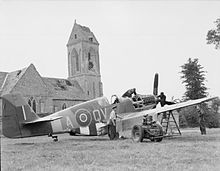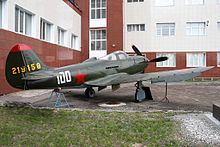Allied technological cooperation during World War II
The
Tizard Mission
The origin of the cooperation stemmed from a 1940 visit by the
Small arms
In addition to those produced in Britain, small arms and ammunition were obtained from
Later, the
Britain supplied small arms to the USSR, and the 9mm Sten submachine gun was supplied to Soviet partisan troops[citation needed].
Artillery
The British made use of many American towed artillery pieces during the war, such as the
The Americans in turn used a British artillery piece, the
Both 76 mm and 75 mm guns were mounted on tanks sent to the Soviets by the US, while the British tanks sent were armed with both the
Another technology taken to the US, by
Tanks and other vehicles
The
The British also used the Sherman hull for two other
The British supplied tanks to the USSR in the form of the Matilda, Valentine and Churchill infantry tanks. Soviet tank soldiers liked the Valentine for its reliability, cross country performance and low silhouette. The Soviet's opinion of the Matilda and Churchill was less favourable as a result of their weak 40-mm guns (without HE shells) and inability to operate in harsh rasputitsa, winter and offroad conditions.[citation needed]
Deliveries of
In 1942, a T-34 and a KV-1 tank were sent by the Soviet Union to the US where they were evaluated at the Aberdeen Proving Ground. Another T-34 was sent to the British.[6]
Aircraft


Britain supplied
The American
The United States supplied several aircraft types to both the Royal Navy and RAF - all three of the U.S. Navy's primary fighters during the war years, the
Radar
The British demonstrated the cavity magnetron to the Americans at RCA, Bell Labs. It was 100 times as powerful than anything they had seen and enabled the development of airborne radar.[7][8][9]
Nuclear weapons
In 1942, the British nuclear weapons research had fallen behind US and unable to match US resources, the United Kingdom agreed to merging their work with the American efforts. Around 20 British scientists and technical staff to America, along with their work, which had been carried out under the
Code-breaking technology
Considerable information was transmitted from the UK to the US during and after WWII relating to code-breaking methods, the codes themselves, cryptoanalyst visits, mechanical and digital devices for speeding code-breaking, etc. When the Atlantic convoys of war material from the US to the UK came under serious threat from U-boats, considerable encouragement and practical help was given by the US to accelerate the development of code-breaking machines. Subsequent co-operation led to significant success in Australia and the far East for breaking encrypted Japanese messages.
Other technologies
Other technologies developed by the British and shared with the Americans and other Allies include
.Technologies developed by the Americans and shared with the British and Allies include the bazooka, LVT, DUKW, Fido (acoustic torpedo). Canada and the U.S. independently developed and shared the walkie-talkie.
Legacy
The Tizard Mission was the foundation for cooperation in scientific research at institutions within and across the United States, United Kingdom and Canada.[13][14][15][16][17]
Many Norwegian scientists and technologists took part in British scientific research during the period when Germany occupied Norway between 1940 and 1945. This resulted in the Norwegian Defence Research Establishment, formed in 1946.
After the war ended, the US ended all nuclear co-operation with Britain. However, the demonstration of
Cooperation between British intelligence agencies and the United States Intelligence Community in the post-war period became the cornerstone of Western intelligence gathering and the "Special Relationship" between the United Kingdom and the United States.[19]
Many military inventions during the war found civilian uses.
See also
- British Purchasing Commission
- List of World War II electronic warfare equipment
- Operations research
- Radiation Laboratory
- Telecommunications Research Establishment
References
- ^ Roberts, Eric (16 March 2004). "British Technology and the Second World War". Stanford University. Retrieved 26 April 2015.
British science and technology was instrumental in winning the Second World War. This course looks at several different technological innovations undertaken in Britain in the context of the wartime period: the breaking of the German Enigma code at Bletchley Park (which Winston Churchill credited with having won the Battle of the Atlantic), the development of radar, the advances in wartime medicine and pharmacology (most notably, the first practical uses of penicillin), and the participation by British scientists in the Manhattan Project.
- ^ Paul Kennedy, Engineers of Victory: The Problem Solvers Who Turned The Tide in the Second World War (2013)
- ^ James W. Brennan, "The Proximity Fuze: Whose Brainchild?," U.S. Naval Institute Proceedings (1968) 94#9 pp 72–78.
- ^ James Phinney Baxter III (Official Historian of the Office of Scientific Research and Development), Scientists Against Time (Boston: Little, Brown, and Co., 1946), page 142.
- ISBN 978-0-89141-087-4.
- ^ Boris Kavalerchik, Voenno-Istoricheskiy Arkhiv, issue No. 1, 2006
- ^ "From World War II Radar to Microwave Popcorn, the Cavity Magnetron Was There - IEEE Spectrum". spectrum.ieee.org. Retrieved 2023-01-14.
- ^ Angela Hind (February 5, 2007). "Briefcase 'that changed the world'". BBC News. Retrieved 2007-08-16.
- ^ Harford, Tim (9 October 2017). "How the search for a 'death ray' led to radar". 50 Things That Made the Modern Economy. BBC World Service. Retrieved 9 October 2017.
- ^ ISBN 9780814208526.
- S2CID 247253473.
- ISSN 0021-1753.
- ^ "How the Tizard Mission paved the way for research at MIT". MIT News | Massachusetts Institute of Technology. 23 November 2015. Retrieved 2023-01-14.
- ^ "The Tizard Mission: 75 years on | Imperial News | Imperial College London". Imperial News. 2 December 2015. Retrieved 2023-01-14.
- ^ "Tizard Mission75th Anniversary Commemoration" (PDF). www.secnav.navy.mil. Office of Naval Research, the British Embassy Washington, and the Embassy of Canada in Washington. Retrieved 2023-01-14.
- ^ "The Tizard Mission – 75 Years of Anglo-American Technical Alliance". National Air And Space Museum. Smithsonian. Retrieved 2023-01-14.
{{cite web}}: CS1 maint: others (link) - ^ "The Tizard Mission: 75 Years of Transatlantic Partnership on Science and Technology". GOV.UK. Retrieved 2023-01-14.
- ^ "Nuclear Treaty still going strong at 50". Defence Policy and Business. Ministry of Defense. 4 September 2008. Retrieved 6 December 2018.
{{cite web}}: CS1 maint: others (link) - ^ Adam White (29 June 2010). "How a Secret Spy Pact Helped Win the Cold War". Time.
